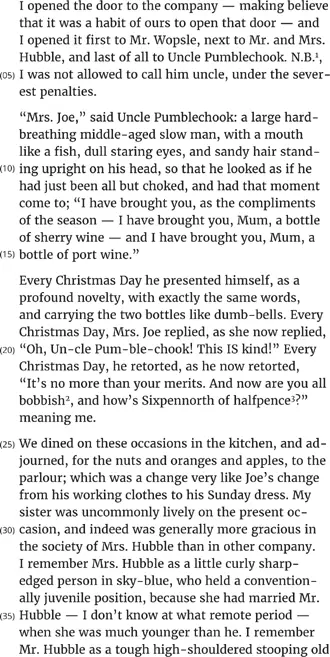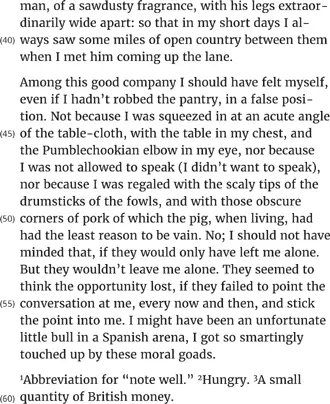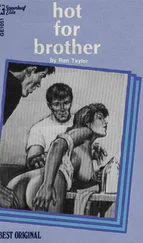(C) Lines 8–10 (“Today’s fertile soil … ruins”)
(D) Lines 10–12 (“as the fall of the … ninth century illustrates”)
34. In the context of Line 8, what is the best definition of “shifts”?
(A) transfers
(B) modifications
(C) swings
(D) adjustments
35. The example of the Mayan civilization serves to
(A) emphasize the importance of water conservation
(B) exemplify how history and climate are related
(C) show that no empire is immune to climate change
(D) reveal how human behavior influences climate
36. Which of the following best expresses the meaning of this statement: “Modern science has in some sense inherited the mantle of ancient seers” (Lines 16–18)?
(A) Much scientific knowledge is as imprecise as magic.
(B) Scientific knowledge isn’t accessible to ordinary people.
(C) Science attempts to predict future events.
(D) Scientists today are expected to understand the past.
37. The author mentions Mt. Toba (Line 30)
(A) as an example of human endurance in the face of climate change
(B) to warn of the dangers of natural forces
(C) to show that volcanoes can do damage
(D) as an illustration of the way human behavior changes when climate changes
38. The author of Passage 2 mentions the oviraptor (Line 48) to show
(A) the difference between human and animal responses to changes in climate
(B) how living creatures adapt to changes in climates
(C) a species that became extinct because of climate shifts
(D) an example of something that lived during a warm period
39. Which choice provides the best evidence for the answer to the previous question?
(A) Lines 42–44 (“But decade … constant motion”)
(B) Lines 45–46 (“On a grand … abnormal”)
(C) Lines 46–47 (“Though most … steamier”)
(D) Lines 48–50 (“When the oviraptor … on average”)
40. Compared to the authors of Passage 1, the author of Passage 2
(A) describes volcanic eruptions as more important factors in climate change
(B) believes that climate change has less effect on human behavior
(C) is more concerned with humans’ effect on climate than the effect of climate on humans
(D) sees climate as having greater historical importance
41. Evidence from both passages supports the idea that
(A) climate change is inevitable
(B) human beings cannot withstand radical climate changes
(C) human activity affects climate
(D) climate changes very little
42. The title that best fits both passages is
(A) Global Warming
(B) Natural Climate Change
(C) Volcanoes and Climate
(D) Human Effects on Climate
1 A. Lines 1 through 4 make clear that the site (that is, the geography and climate) where people live is a factor in human culture, a belief expressed by Choice (A). Did Choice (C) entrap you? Lines 10–12 refer to the fall of the Mayan Empire because of extreme drought, but Line 3 firmly asserts that climate isn’t the sole factor determining the stability of a civilization.
2 A. Check out the answer explanation to Question 32, and you see that the lines in Choice (A) support the idea that history is intertwined with geography.
3 C. Lines 6–8 tell you that “climate has undergone many variations … so, too, are there shifts in civilizations.” The word too tells you that you’re looking for a synonym of variations, which Choice (C) provides. Choice (B) is close, but a modification usually refers to a small change to an existing thing, and the paragraph describes more extreme changes.
4 B. The Mayan empire fell because of a prolonged drought (Lines 10–11), so you can immediately eliminate Choices (C) and (D). To choose between the remaining two answers, examine the whole paragraph, which discusses the effect of climate on human culture. In that context, Choice (B) is the best answer.
5 C. Ancient seers tried to predict the future, and Lines 15–16 tell you that today’s scientists are “preparing for major shifts in trade, population density, and political affinity” — future trends, in other words. Hence, Choice (C) is correct.
6 A. The third paragraph of Passage 1 (Lines 24–35) talks about climate and culture. The passage states that the eruption of Mt. Toba brought on an ice age, but — and this is an important but — human culture survived intact (not damaged or broken). Therefore, Choice (A) is your best answer here.
7 A. Choices (A), (B), and (C) are out because the second paragraph of Passage 2 states that “through most of the dinosaur era the planet’s normal state was decidedly steamier.” This also makes Choice (D) the correct answer.
8 C. Lines 46–47 state that “most of the dinosaur era,” the earth was warmer, so the climate didn’t change and thus affect the oviraptor.
9 C. Lines 64–66 state that “human industry has wrought profound changes in the Earth’s atmosphere since the last warm period.” Thus, the author considers how humans affect climate, not the other way around, as is the case in Passage 1. Go for Choice (C).
10 A. Passage 1 makes a point of stating that climate isn’t “a constant” (Line 5), and Passage 2 flat out tells you that climate is always changing. Therefore, Choice (A) fits perfectly. Choice (C) may have lured you because the author of Passage 2 does state that human activity is a factor; Passage 1, however, ignores the human effect on the weather.
11 B. Choice (A) is out because Passage 1 talks about Mt. Toba, which led to global cooling (not warming). Passage 2 doesn’t really deal with volcanoes, so Choice (C) is also out. Passage 1 ignores human effects on climate, so the answer can’t be Choice (D). As a result, Choice (B) is the correct answer.
 Questions 43–52 are based on the following passage.
Questions 43–52 are based on the following passage.
In this excerpt from Dickens’s 19th-century novel Great Expectations , the narrator recalls a Christmas dinner.


43. Which statement about the opening of doors may be inferred from the first paragraph (Lines 1–6)?
(A) The door that the narrator opens is normally locked.
(B) The door that the narrator opens is never used for company.
(C) The narrator is not normally allowed to open the door for visitors.
(D) Certain doors are used on special occasions and others for everyday entries.
44. The author’s attitude toward Uncle Pumblechook and Mrs. Joe in the second and third paragraphs (Lines 7–24) may best be characterized as
(A) mildly critical
(B) admiring
(C) ambivalent
(D) sharply disapproving
45. Which choice provides the best evidence for the answer to the previous question?
(A) Lines 5–6 (“I was not allowed … severest penalties”)
(B) Lines 8–10 (“middle-aged slow man … upright on his head”)
(C) Lines 16–20 (“Every Christmas Day … This IS kind”)
(D) Lines 28–31 (“My sister was uncommonly … than in other company”)
46. In the context of Line 9, which of the following is the best definition of “dull”?
Читать дальше

 Questions 43–52 are based on the following passage.
Questions 43–52 are based on the following passage.












